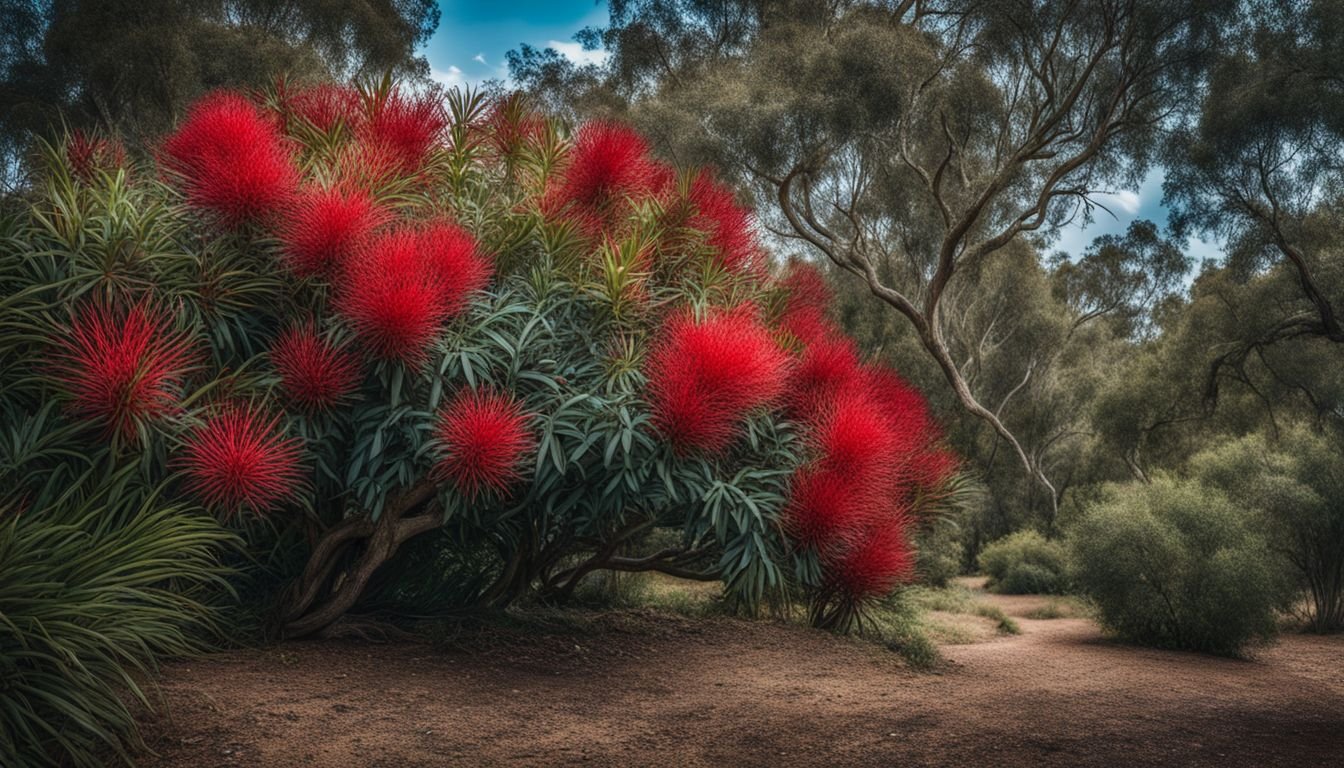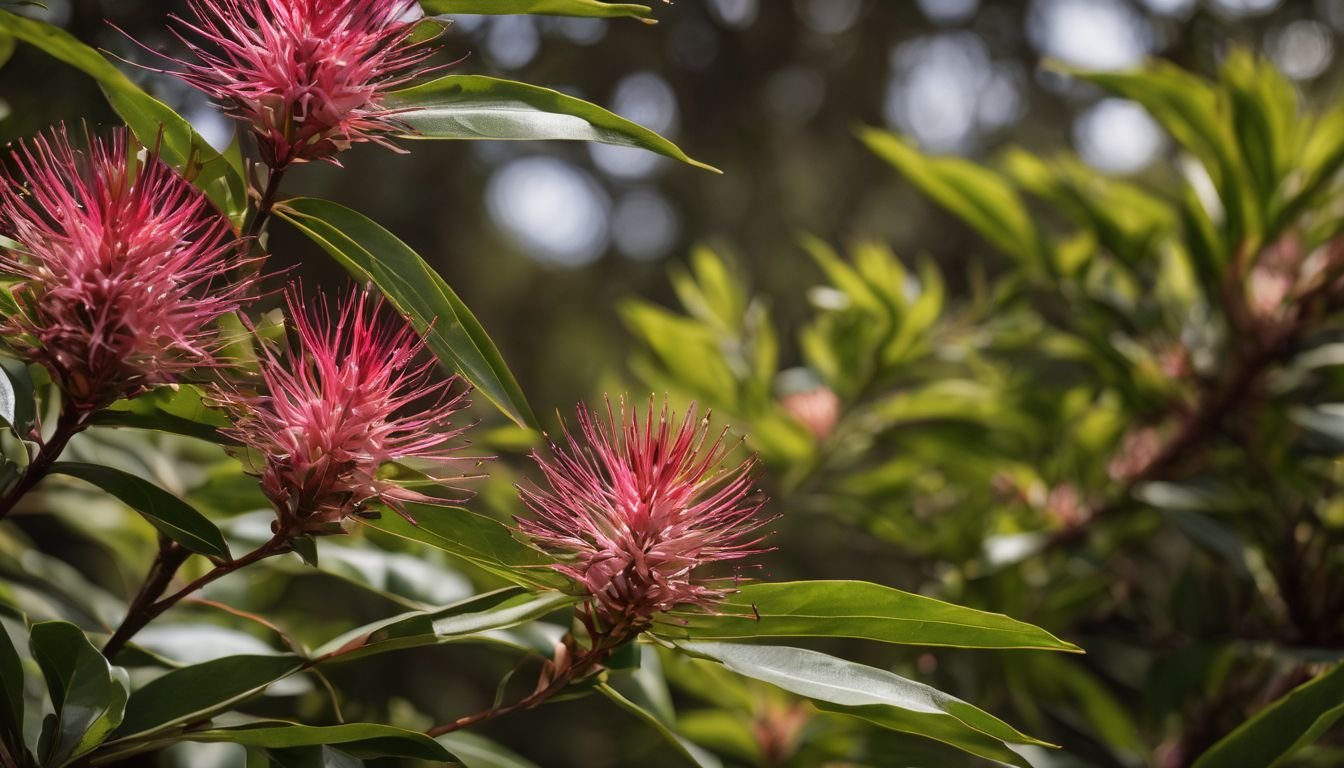Gardeners adore Hakea Laurina for its unique, pincushion flowers, but sometimes this Australian native can be tricky to keep healthy. Known as the Pincushion Hakea or Kodjet, it’s a stunning plant that demands specific conditions to thrive.
This article will guide you through typical problems and arm you with effective solutions to ensure your Hakea Laurina remains a garden highlight. Discover how to combat these issues and enjoy lush, vibrant growth from your beloved plant.
Key Takeaways
- Hakea Laurina, also known as the Pincushion Hakea, needs specific conditions like full sun and well – drained soil to avoid problems such as root rot fungus.
- Regular pruning after the flowering season helps maintain this plant’s health, encourages new growth, and prevents invasive spread.
- To protect against Phytophthora fungus and root rot, ensure good drainage in the soil and adjust watering habits according to weather changes – more during dry spells and less when it’s cooler or wetter.
- Address potential issues early by checking for wilted leaves or stunted growth which can be signs of fungal diseases; take action immediately by improving soil quality or cutting away infected parts.
- Choose sandy or loamy soils that mimic the plant’s natural habitat for optimal growth and create an open space setting similar to its coastal origins.
Brief Description of Hakea Laurina

Moving on from the introduction, Hakea Laurina displays a striking presence in any garden with its unique floral display. Thriving in full sun and well-drained soils, this small tree or large shrub is an iconic part of south-western Australia’s native flora.
Its stunning red and cream flowers resemble pin cushions, giving it one of its nicknames: Pin-cushion Hakea.
The plant boasts attractive blue-green foliage that provides year-round interest and makes it a favorite among native plant enthusiasts. It adapts to coastal conditions effortlessly and reaches maturity quickly compared to other trees.
With proper care, Hakea Laurina becomes a resilient addition to gardens, attracting an array of birdlife while offering beautiful flowers that can be admired up close or from afar.
Common Issues with Hakea Laurina

Despite its rugged beauty and resilience, Hakea Laurina is not without its challenges in the garden. Garden enthusiasts may encounter a handful of prevalent issues that can impact the health and aesthetic appeal of this native species.
Root Rot Fungus
Root rot fungus spells trouble for the usually hardy Hakea Laurina. This pesky disease can sneak up, leaving your beloved plant with wilting leaves and a sickly appearance. Native plants like the Hakea are not immune to such fungal foes; they need our help to fight back.
To tackle root rot in your garden, first check that the soil around your Hakea isn’t overly wet. A good drainage system is crucial as soggy roots make an inviting home for fungus. If you suspect root rot, gently remove your plant from its pot or dig around its base if it’s in the ground.
Look out for brownish-black roots – healthy ones should be firm and white. Snip off any affected parts and replant using fresh mulched potting mix that will let those vital roots breathe easy once more.
Caring steps like these can coax even a struggling Hakea Laurina back to vibrant health, allowing you to enjoy its unique seedpods without the fear of environmental weeds taking over your serene space.
Susceptibility to Phytophthora Fungus
Root rot fungus isn’t the only culprit threatening Hakea laurina; this plant also faces challenges from Phytophthora fungus. This insidious organism attacks the roots and can cause significant damage, hindering nutrient uptake and leading to die-back of branches.
Vigilance is key in detecting early signs such as yellowing leaves or stunted growth.
Protecting your beloved Hakea Laurina from this fungal foe involves ensuring good drainage and avoiding overwatering. Plant lovers should be particularly cautious during wet seasons, as Phytophthora thrives in overly moist conditions.
To keep plants healthy and resilient against such pathogens, adopting proper soil selection practices plays a crucial role.
Invasive Growth
Moving beyond the susceptibility to Phytophthora fungus, Hakea Laurina also poses challenges with its propensity for invasive growth. Thriving in various environmental conditions, this plant can quickly spread beyond garden borders and disrupt local ecosystems.
Vigilance is key in managing its expansion as it competes aggressively with native flora, threatening biodiversity.
To keep Hakea Laurina’s vigorous seedling proliferation in check, land managers must adopt proactive measures. Regular pruning keeps the evergreen at bay while strategic planting within controlled garden settings prevents unintended spread into wild habitats.
Conservationists pay close attention to these practices to protect regional plant life balance and maintain ecological integrity.
Solutions for Hakea Laurina Problems
Addressing the challenges of Hakea Laurina cultivation requires a blend of horticultural expertise and practical know-how, paving the way for healthier plants and more vibrant gardens.
Proper Watering Practices
Hakea Laurina thrives with minimal water, but achieving the right balance is crucial for its health. Proper watering practices can prevent root rot and ensure your plant grows strong and healthy.
- Check the soil before watering: Use your fingers to test the moisture level a few centimeters below the surface. If it’s dry, it’s time to water; if damp, wait a few more days.
- Water deeply but infrequently: When you do water, soak the soil thoroughly so that water reaches deep roots. Then allow the soil to dry out before watering again.
- Ensure well-drained soil: Plant Hakea Laurina in soil that drains well to avoid waterlogging, which can lead to root rot fungus.
- Avoid overhead watering in the evening: Damp leaves overnight can attract botrytis, a fungal problem. Water in the morning so leaves dry during the day.
- Adjust watering with seasons: Hakea Laurina needs less water during cooler months and more during hot periods. Monitor changes in weather and adjust accordingly.
- Use mulch wisely: A layer of mulch conserves moisture but keep it away from the stem base to prevent unwanted humidity and potential fungal issues.
Regular Pruning
Regular pruning stands as a crucial task for maintaining the health and appearance of Hakea Laurina. It encourages fresh growth and allows your plant to flourish with abundant flowers.
- Aim to prune your Hakea Laurina after its flowering period has come to an end. This timing promotes the best possible display of blooms in the following season.
- Cut back any dead or diseased branches as soon as you spot them. Removing these parts prevents the spread of disease and maintains the plant’s vitality.
- Shape your perennial carefully to control its size and preserve its natural form, ensuring it complements your garden’s aesthetics.
- Focus on thinning out dense areas to improve air circulation within the canopy. This step is vital for reducing fungal infections and promoting robust health.
- Use sharp, sanitised pruning tools for each cut you make. Clean cuts heal faster and reduce the risk of infection, safeguarding your plant’s well-being.
- Keep an eye on invasive growth patterns. Control these promptly by cutting back vigorous shoots that may otherwise dominate surrounding vegetation or escape desired boundaries.
- Prune strategically to avoid over – pruning which can stress the plant; instead, aim for moderate trimming that supports steady growth and development.
Proper Soil Selection
Selecting the right soil for your Hakea Laurina is crucial to its success. This striking plant demands well-draining ground to prevent issues like root rot, which can be fatal if not managed properly.
Think sandy or loamy soils that mimic its natural coastal habitat – these types will encourage healthy growth and keep those vibrant pincushion flowers blooming. Avoid heavy clay soils; they retain moisture and could spell disaster for the shallow roots of your Hakea.
Ensuring optimal conditions, match your selection with a spot offering open spaces that cater to this Australian native’s preferences. Now, let’s move on to mastering proper watering practices to help your Hakea thrive in its new environment.
Conclusion
Caring for Hakea Laurina brings joy and a touch of Australian beauty to your garden. Tackling common issues with determination will ensure that your pincushion blooms thrive. Remember, well-drained soil and the right amount of sunlight are key to keeping troubles at bay.
Embrace regular pruning and watch out for signs of root or fungus problems early on. With these solutions in hand, your Hakea Laurina will stand as a testament to nature’s splendor and your gardening expertise.
For further insights on caring for exotic plant species, explore our comprehensive guide to the Dragon Tree.
FAQs
1. What are common issues with Hakea Laurina seed germination?
Common problems with Hakea Laurina seed germination include lack of moisture, incorrect soil temperature, and inadequate light exposure.
2. How can I improve the germination rate of my Hakea Laurina seeds?
To enhance the germination rate, ensure your seeds have consistent moisture, are planted in well-draining soil at the correct depth, and receive enough warmth and light.
3. Can overwatering affect my Hakea Laurina’s growth?
Yes, overwatering can lead to root rot and other fungal diseases that harm the growth of your Hakea Laurina plants.
4. Are there any similarities between growing banksia and Hakea Laurina?
Both banksia and Hakea Laurina thrive in similar conditions; they prefer well-drained soils and need proper sunlight to grow effectively.
